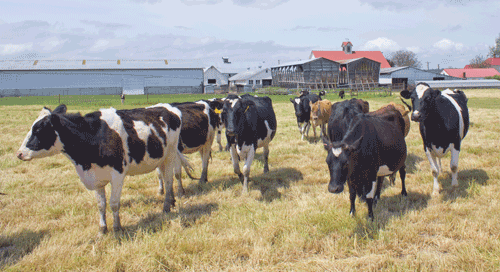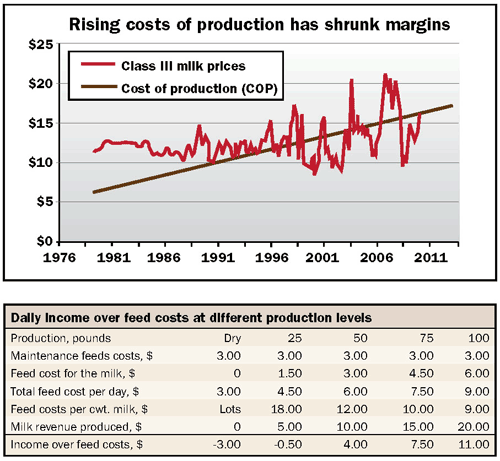Bethard is with Dairy Records Management Systems, Raleigh, N.C., and G&R Dairy Consulting, Wytheville, Va. Nunes is with Genske, Mulder & Company, Salida, Calif. 
High cull rates and low production are two common strategies many avoid with replacements. However farms can be profitable with both supposed problems. It takes a different look, and an accurate account, at a farm's data.
The top three costs of producing milk on most dairies in the U.S. are feed, replacements, and labor. Normally expressed on a hundredweight basis, these three key areas depend greatly on herd performance and your management skills.
Conceptually, replacement cost is the cost of maintaining herd size and structure. Although dairy accountants have various methods to determine replacement costs, all methods basically are similar in concept. The formula [(value of cows sold minus cost of replacement) divided by hundredweight milk sold] is the basis for determining replacement costs.
Often, cull rate or herd turnover is used to measure herd health and replacement success. When fully considering the concept and implications of replacement cost, it becomes obvious that cull rate or any measure of herd turnover is a poor proxy for herd health or cost of maintaining herd size. The best measure of successful herd replacement is replacement cost per hundredweight, and a reasonable goal in most areas of the country is less than $1.50.
Since it normally is expressed on a hundredweight basis, replacement cost doesn't depend on herd size or production level. It can be compared for herds milking 100 cows or 10,000 cows or for herds milking 50 pounds per day or 100 pounds. In the simplest of terms for a 1,000-cow herd, replacement cost is the cost of keeping 1,000 cows in the herd day after day.
Generally Accepted Accounting Principles (GAAP) are rules that all accountants in the U.S. are required to follow when preparing accrual-based financial statements. For dairy purposes, when a cow is put into productive use, the cost is depreciated over the animal's useful life which usually is 5 to 7 years. It is referred to as depreciation of dairy cow's expense. Once the cow is removed from the herd (sold or died), the remaining cost that has not been depreciated is removed and compared to the cull cow proceeds.
The cash method for determining replacement costs utilizes the following formula:
(Cost of raising or purchasing replacements) minus (cull cow income) divided by hundredweights of milk produced.
The first part of the numerator is "cost of raising or purchasing replacements" which includes all costs incurred for getting a heifer to the day of calving. For home-raised heifers, this includes all costs from birth until day of calving and includes feed, labor, vaccines, health treatments, equipment costs, and so forth.
Which expenses?
To answer the question "should an expense be included in replacement costs," consider whether this cost would go away if the heifers were off site. If the answer is yes, then it should be part of replacement cost.
For purchased heifers, it includes all costs involved with purchasing the animal, including hauling and commissions. It also includes the costs incurred from the time of purchase until calving, such as feed, labor, and health costs.
The second part of the numerator is "cull cow income." This includes the revenue received from selling cull cows and cull heifers plus any revenue received from selling heifers for dairy purposes.
In a situation where all heifers are purchased, the value of heifer calves sold can be included in the value of cows sold.
The table illustrates replacement costs for four 1,000-cow herds with varying cull rates, death losses, and production levels. The four herds dispel some of the myths related to replacement costs.

Five myths dispelled
Myths dispelled from the table.
Myth Number 1: High cull rate means high replacement costs. This often is true but not always. Herd D is a high-producing herd that has excellent herd health. Death loss is relatively low, and the cull cows are valuable. The dairy ships a lot of milk which dilutes the replacement costs over more hundredweights.
Myth Number 2. Low production is not a viable business model. Actually, a low-production, low-input model can be very successful, provided feed, labor, and replacement costs are low. Lower-producing herds can achieve low replacement costs by having low death loss, low cull rate, and high-quality culls. Herd C is an example of this.
Myth Number 3. A dairy only sells milk. Truth is you also sell a lot of beef. The quality of cows being sold greatly affects cull cow income and replacement costs. Selling heavier, late-lactation cows is very different from selling skinny, fresh cows or thin, lame cows. The high death loss and low value of culls is killing Herd B.
Myth Number 4. Lowering cull rates will always lower replacement costs. Nope. Depending on market conditions, simply lowering cull rate may not improve replacement costs. Keeping low-producing cows and holding on to cows too long to where their cull value is lessened typically will not improve replacement costs.
Myth Number 5. Herd health is tied to cull rate. Low replacement costs result from a healthy herd where management makes good economic decisions on cows, regardless of cull rate. Herd D is a high-producing herd with a high cull rate but reasonable replacement costs. Unhealthy herds like Herd B have higher death loss, poorer quality culls, and higher replacement costs despite reasonable cull rates.
Additional Coverage
Dairyman Extras feature: "Accrual accounting for replacement costs"
Click here to return to the Calf & Heifer E-Sources
110825_526

The top three costs of producing milk on most dairies in the U.S. are feed, replacements, and labor. Normally expressed on a hundredweight basis, these three key areas depend greatly on herd performance and your management skills.
Conceptually, replacement cost is the cost of maintaining herd size and structure. Although dairy accountants have various methods to determine replacement costs, all methods basically are similar in concept. The formula [(value of cows sold minus cost of replacement) divided by hundredweight milk sold] is the basis for determining replacement costs.
Often, cull rate or herd turnover is used to measure herd health and replacement success. When fully considering the concept and implications of replacement cost, it becomes obvious that cull rate or any measure of herd turnover is a poor proxy for herd health or cost of maintaining herd size. The best measure of successful herd replacement is replacement cost per hundredweight, and a reasonable goal in most areas of the country is less than $1.50.
Since it normally is expressed on a hundredweight basis, replacement cost doesn't depend on herd size or production level. It can be compared for herds milking 100 cows or 10,000 cows or for herds milking 50 pounds per day or 100 pounds. In the simplest of terms for a 1,000-cow herd, replacement cost is the cost of keeping 1,000 cows in the herd day after day.
Generally Accepted Accounting Principles (GAAP) are rules that all accountants in the U.S. are required to follow when preparing accrual-based financial statements. For dairy purposes, when a cow is put into productive use, the cost is depreciated over the animal's useful life which usually is 5 to 7 years. It is referred to as depreciation of dairy cow's expense. Once the cow is removed from the herd (sold or died), the remaining cost that has not been depreciated is removed and compared to the cull cow proceeds.
The cash method for determining replacement costs utilizes the following formula:
(Cost of raising or purchasing replacements) minus (cull cow income) divided by hundredweights of milk produced.
The first part of the numerator is "cost of raising or purchasing replacements" which includes all costs incurred for getting a heifer to the day of calving. For home-raised heifers, this includes all costs from birth until day of calving and includes feed, labor, vaccines, health treatments, equipment costs, and so forth.
Which expenses?
To answer the question "should an expense be included in replacement costs," consider whether this cost would go away if the heifers were off site. If the answer is yes, then it should be part of replacement cost.
For purchased heifers, it includes all costs involved with purchasing the animal, including hauling and commissions. It also includes the costs incurred from the time of purchase until calving, such as feed, labor, and health costs.
The second part of the numerator is "cull cow income." This includes the revenue received from selling cull cows and cull heifers plus any revenue received from selling heifers for dairy purposes.
In a situation where all heifers are purchased, the value of heifer calves sold can be included in the value of cows sold.
The table illustrates replacement costs for four 1,000-cow herds with varying cull rates, death losses, and production levels. The four herds dispel some of the myths related to replacement costs.

Myth Number 1: High cull rate means high replacement costs. This often is true but not always. Herd D is a high-producing herd that has excellent herd health. Death loss is relatively low, and the cull cows are valuable. The dairy ships a lot of milk which dilutes the replacement costs over more hundredweights.
Myth Number 2. Low production is not a viable business model. Actually, a low-production, low-input model can be very successful, provided feed, labor, and replacement costs are low. Lower-producing herds can achieve low replacement costs by having low death loss, low cull rate, and high-quality culls. Herd C is an example of this.
Myth Number 3. A dairy only sells milk. Truth is you also sell a lot of beef. The quality of cows being sold greatly affects cull cow income and replacement costs. Selling heavier, late-lactation cows is very different from selling skinny, fresh cows or thin, lame cows. The high death loss and low value of culls is killing Herd B.
Myth Number 4. Lowering cull rates will always lower replacement costs. Nope. Depending on market conditions, simply lowering cull rate may not improve replacement costs. Keeping low-producing cows and holding on to cows too long to where their cull value is lessened typically will not improve replacement costs.
Myth Number 5. Herd health is tied to cull rate. Low replacement costs result from a healthy herd where management makes good economic decisions on cows, regardless of cull rate. Herd D is a high-producing herd with a high cull rate but reasonable replacement costs. Unhealthy herds like Herd B have higher death loss, poorer quality culls, and higher replacement costs despite reasonable cull rates.
Additional Coverage
Dairyman Extras feature: "Accrual accounting for replacement costs"
110825_526








